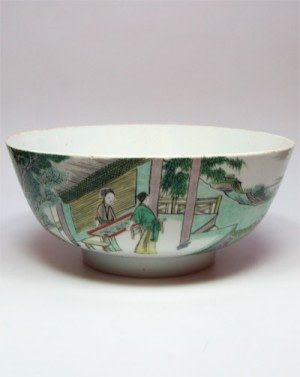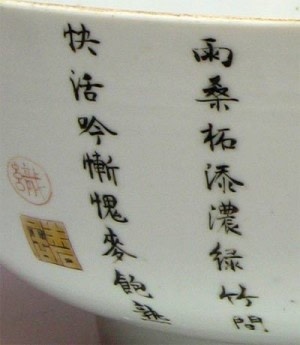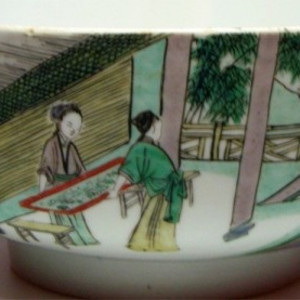Further images
Exquisitely painted in the famille verte palette, with scenes from Silk Weaving No 3, The Third Stage of Growth, (and we quote: During this stage the silk worms must be fed during the whole day). On a terrace under a thatched roof and infront of a screen, a lady reclines on a day bed, whilst two other ladies sort the silkworms in trays, a dog nearby watches on, a small dog plays in front of a round table, amusing the resting lady, the scene framed by verdant trees, gnarled trunks in green and brown enamels, above the terrace a stylised cloud formation in green, yellow, iron red and aubergine enamels, the back painted with a six line poem, with three seals, the other bowl with a scene from Weaving No 6, Sorting of the Mulberry Leaves, (and we quote: Because of the fine weather, there is a good crop of mulberry leaves. The producers have to spend a great deal of time sorting the good from the bad). Two ladies on a terrace, holding a long tray, sorting mulberry leaves, in the shade of trees, outside the terrace an undulating mossy path, along which two further ladies are engrossed in conversation and a little boy, stroll, in the foreground to the side of the scene, hilly land and trees, on the back a six line poem with three seals.
Literature
These scenes are from Keng-Chi Tu, ( The Pictures Of Ploughing And Weaving) published in 1712 by the Imperial Order of the Emperor Kangxi. It comprised a series of twenty three wood-cut drawings illustrating the various processes in these pursuits. The potters at Jingdezhen copied the scenes on to porcelain, nearly always using the famille verte palette. This is particularly interesting as it helps date these pieces with some precision, the common consensus being that they would have been produced 1712 +/- five years. Many illustrations on porcelain are accompanied by the text found on the woodcuts.
Kang Hsi Imperial Order Edition, drawn by Chao Ping-Cheng; woodblocks carved by Chu Kwei; Preface of Kang Ji To.
Much time has been spent by me in studying the basic principle of livelihood and after reading many books, my conclusion is that food and clothing are most important to a mans life, and I think that this principle should be observed by every man who has a chance to rule a country.
Long ago this point had already been realized. The people of Si Han said that: hunger is caused by poor harvest and cold by unsuccessful weavers. They also said that if there is sufficient food and clothing, even an old man could live as long as he should, and an orphans life could be as happy as other children with parents.
Whenever I visit other provinces, I used to pay attention to the plantation there. I am interested in their soils, climates and also methods of controlling pests. The Fung Chun Garden is a place where I love to spend a great deal of time with my noblemen. Next to it are several acres of planted lands irrigated by running streams. Sound of the wooden mills is audible and the annual harvest is enormous. Near to the bank are the mulberry trees and silk-worm houses where silk is produced. There is a Chiu Yuen Pavillion nearby where we may watch all these in action.
The learned in olden days used to say: When clothed we should remember the work done by the weavers, and when fed we should realize the hardship of the farmers, and for this reason I published this book with 23 pictures on each topic, and a poem is also written on each chapter to praise the tremendous effort made by the farmers and weavers. A mould is also made for this book so that in future all my successors and people willl know how much the farmers and weavers have worked for us in order to feed and clothe us, and my successors will be reminded that the principle of life is diligence and frugality. With sufficient food and clothing the country will grow.
Written in the 2nd Moon of the 35th of Kang Hsi.






